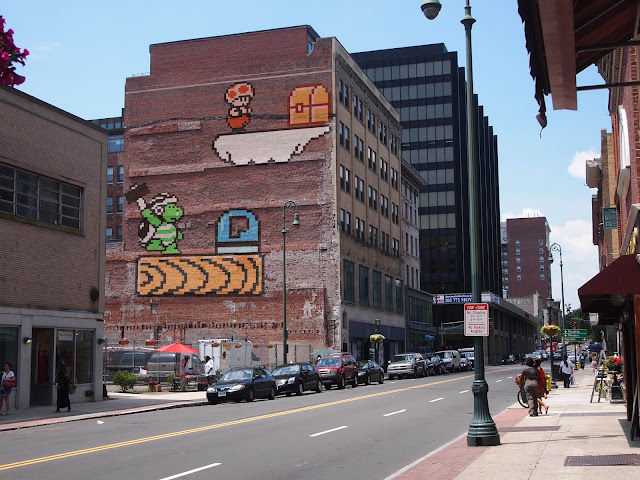Here are some proposals, and an explanation about why those proposals were selected and developed.
Example #1. Foxon Park Above Gourmet Heaven
This is a local soda company ("Foxon Park"). It exists and you can buy it in the store "Gourmet Heaven." The practicality of this move features several different components:
- It takes over a space which has been targeted in the past by graffiti vandals, and puts it in the realm or space of commerce, meaning art for work, and opens the door to a pathway for businesses and artists to blend on the street art level, in a mutually beneficial way.
- It's a local soda, only available in this specific region of the country, so it adds unique character to this scene, making it less likely you'd see such a thing anywhere else.
- Looks pretty good all photoshopped below as such, doesn't it?
Example #2: Parking Structure on Orange
This one indicates where people can park, and makes use of marquee space on the building facade.
It incorporates the font "Federation" which has typically been seen in certain context on the internet, and puts it precisely on the wall the way that some child would on photoshop.
It also challenges painters to be precise and use "gradients" while staying within budget. The cheaper the work is completed, the more the artists can take home. The faster the work is completed, the more quick the artists can leave town and take a great road trip with the money they've earned. But the skill of the artist is in balancing all of these factors, while staying within the bounds of what one would call "Gallery Precision," meaning that anyone seeing it from any perspective would not be able to find funk or defect in the design and painting of the original artwork. Also, OSHA 10 would be in order, as well as scaffolding.
The Biggest Challenge
Here would be an example of an artwork which would take a tremendous amount of time to complete within the bounds of what would be considered "Verbatum" or "True to Form." Since 8-bit shapes are, in fact, bitmaps, these would need to be applied using a measurement tool and a "map" (the original game) in order to make these items to appear the way that they do on the screen. The illusion to the eye of any beholder would be one of wonder. To the game manufacturers, a sense of reverence for the miraculous mind puzzles that the original Japanese programmers originated: Videogames.
But that particular project would involve a tremendous amount of community support, approval from the aldermen, and probably the encouragement from the efforts of the aforementioned previous works. It is, in my opinion, a matter of proving ground to lay out the groundwork with simple projects, and move on to much more difficult things. By showing the public that art can improve a vacant wall just as an amazing structure might improve a parking lot of gravel.
Also, if a new building is assembled in the adjacent vacant lot to take over that wall, the artwork would be preserved between those buildings for what might be considered hundreds, if not thousands of years.
So, proving ground first. All things in life revolve chronologically over what seems naturally the most likely to occur. We're going to be employing some of the best local artists on these projects, basing our pricing on realistic expectations established by the structure that currently stands.
 Step One. Find out how much this billboard costs. It's CBS Billboard 1228-B, on the corner of Whitney and Grove.
Step One. Find out how much this billboard costs. It's CBS Billboard 1228-B, on the corner of Whitney and Grove. Take that number. Let's say you negotiate it to $2000/mo over the phone. Assume that the wall down the street gets half the traffic. So the visibility declines in worth to about $1000.
Now figure out a way to manage to obtain a figure comparable which will allow you to sustain your existence with art.
Here is a good example of this equation. Let's say that it will cost $1000 to produce. The supplies will be about $500. The artist will also cost the same. But the monthly fee would come from the advertiser, meaning that Foxon Park would essentially be the party responsible for paying the building owner to "Rent" the location. And that a new mural would be installed whenever either party requested.
Foxon Park could say, "We no longer want to pay the building owner $200 every month for their wall. It doesn't make sense to us, to pay that much."
The building owner could then say, "We will call up the sign company people and find a new company who would like to advertise on that wall, for the $1000 paint fee as well as the $200 monthly wall space rental. It gets more local traffic than the internet, and everyone on this street is well-to-do! Foxon Park would be fools not to continue to use that wall!"
I suppose the dialogue is a little 1950's but I'd be prepared not just for art, but for conversation and business arrangements. The public sphere is a great place to take shape a career. And that's how I will end this entry into the Stereomedia Journal.




No comments:
Post a Comment